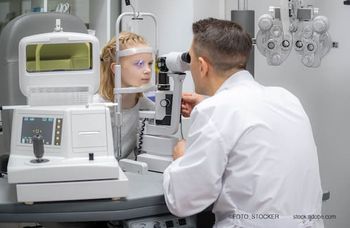
- Ophthalmology Times: September 1, 2020
- Volume 45
- Issue 14
Improving surgical safety, efficiency, and outcomes for patients
Benefits of intracameral phenylephrine/ketorolac continue to add up.
Premarketing studies investigating phenylephrine and ketorolac intraocular solution 1%/0.3% (Omidria, Omeros) provided evidence leading to the product’s approval for maintaining pupil size by preventing intraoperative miosis during
Now, a growing number of real-world studies document that the combined actions of the 2 ingredients translate into additional clinically meaningful benefits.
Related:
For those reasons, leading surgeons value phenylephrine/ketorolac as a core component in all
“I do not operate without phenylephrine/ketorolac because it facilitates the procedure from beginning to end in routine and complicated cases,” said Mitchell A. Jackson, MD, the founder and CEO of Jacksoneye in Lake Villa, Illinois.
According to Jackson, using phenylephrine/ketorolac makes the entire case easier.
“It minimizes the potential for unnecessary additional surgical trauma, the risk of complications, and the need for ancillary strategies to address small pupils,” he said. “Phenylephrine/ketorolac also increases efficiency and can improve facility profitability.”
In 2018, Steven M. Silverstein, MD, published findings from a double-blind, randomized, placebo-controlled study demonstrating the efficacy of intracameral phenylephrine/ketorolac for maintaining pupil dilation and preventing iris billowing and prolapse in patients taking tamsulosin who were at risk for intraoperative floppy iris syndrome (IFIS).1
Related:
He also told Ophthalmology Times® that he uses the product in all of his cataract surgery cases and not just for patients at high risk for pupil issues intraoperatively.
“I certainly appreciate having phenylephrine in the eye to maintain pupil mydriasis, but I think it is also especially valuable that ketorolac is present and bathing uveal tissue at the time when surgical trauma first occurs,” said Silverstein, president of Silverstein Eye Centers in Kansas City, Missouri, and clinical professor of ophthalmology at Kansas City University of Medicine and Biosciences in Kansas City.
“Ketorolac blocks production of prostaglandins that lead to corneal edema, anterior chamber inflammation, and cystoid macular edema (CME),” he said. “As a result, patients benefit with greater comfort, quieter eyes, and more rapid visual recovery, which together translate into greater patient satisfaction.”
Jackson agreed. He said he does a lot of femtosecond laser–assisted cataract surgery, and the femtosecond laser treatment causes release of prostaglandins that can cause faster intraoperative miosis.
“Injecting phenylephrine/ketorolac intracamerally at the start of the case and adding it to the irrigating solution minimizes that concern,” he said.
Related:
Real-world research
Silverstein said he chose to study the use of intracameral phenylephrine/ketorolac in patients at risk for IFIS because individuals who were on an α1-receptor antagonist were excluded from participating in the phenylephrine/ketorolac premarketing clinical trials.
His study protocol was novel in that every case was digitally recorded externally from the perspective of the operating microscope and internally using an endocyclophotocoagulation probe.
The video content was analyzed using sophisticated software to obtain accurate and objective measurements of pupil size, iris billowing, and iris flaccidity that allowed him to create a grading scale of iris billowing severity.
The study included a total of 50 patients who were randomly assigned to undergo surgery using standard irrigation solution or with phenylephrine/ketorolac added.
Related:
The results showed that the signs and symptoms of IFIS were dramatically reduced in the group receiving intracameral phenylephrine/ketorolac, Silverstein said.
The incidence of iris prolapse was 12% in the phenylephrine/ketorolac group, compared with 56% in controls. Iris billowing occurred in 4% of eyes exposed to phenylephrine/ketorolac and 40% of controls.
The differences between groups were statistically significant, as were differences favoring phenylephrine/ketorolac in analyses of pupil diameter at various times intraoperatively and changes in pupil diameter from baseline to different intraoperative timepoints.
“When I operate with phenylephrine/ketorolac, I feel as if the iris tissue turns to concrete,” Jackson said. “The medication is so effective in maintaining iris tone that the tissue is immobilized and the pupil remains dilated.”
Related:
Reducing intraoperative interventions
Results of studies showing the benefits of intracameral phenylephrine/ketorolac for reducing the need for pupil expansion devices include a retrospective study by Frank Bucci Jr, MD, who reviewed 1004 consecutive cases performed without intracameral phenylephrine/ketorolac and 915 consecutive cases done with its use.2
In this large cohort of patients, use of intracameral phenylephrine/ketorolac was associated with a 63% reduction in the frequency of Malyugin ring placement.
Denise Visco, MD, reported findings on pupil expansion device use in a smaller case-control study that included 46 patients who were deemed at risk for intraoperative miosis.3
No eyes that received intracameral phenylephrine/ketorolac needed a pupil expansion device compared with 50% of controls who underwent surgery with epinephrine added to the irrigating solution.
“Avoiding the need for a pupil expansion device reduces facility costs associated with the device itself, but as reported by Visco, it also saves operating room time, and it minimizes surgical trauma and the complications that can occur with device use,” Jackson said.
Related:
Better postoperative outcomes
Reported decreases in CME and in postoperative breakthrough iritis with phenylephrine/ketorolac use can be tied to the reduction in surgical trauma and ketorolac-mediated inhibition of prostaglandin production, Jackson said.
In another retrospective study including 2218 eyes, Visco reported that compared with a control group that received topical loteprednol preoperatively, patients who received phenylephrine/ketorolac had a 65% reduction in rates of both clinical CME and breakthrough iritis.4
In research presented at a recent American Society of Cataract and Refractive Surgery symposium, Keith Walter, MD, reported a CME rate of 0.4% in a series that included 504 eyes on whom he had performed cataract surgery using phenylephrine/ketorolac with only a topical nonsteroidal anti-inflammatory drug (NSAID) postoperatively.5
“I always use both an NSAID and steroid postoperatively, because I think the steroid helps minimize corneal edema, but the 0.4% rate of CME in Walters’ study is striking because to my knowledge, it is the lowest incidence of postcataract surgery CME reported in the published literature,” Jackson said.
Related:
First-hand experience
Although the evidence on the benefits of phenylephrine/ketorolac is compelling, Jackson noted that surgeons may find personal experience most convincing. He cited feedback obtained from his fellows.
“Ophthalmologists-in-training are usually not exposed to phenylephrine/ketorolac during their residency program, but I am a mentor for cataract and refractive surgery fellows through the SF Match,” he said. “Every fellow who has worked with me in the past few years immediately notices the difference when operating with phenylephrine/ketorolac and hopes to incorporate it when they are in practice on their own.”
--
Mitchell A. Jackson, MD
e:[email protected]
Jackson served as medical monitor for a premarketing study of phenylephrine/ketorolac and is a consultant to Omeros.
Steven M. Silverstein, MD
e:[email protected]
Silverstein is a researcher, consultant, and lecturer for Omeros.
References
1. Silverstein SM, Rana VK, Stephens R, et al. Effect of phenylephrine 1.0%-ketorolac 0.3% injection on tamsulosin-associated intraoperative floppy-iris syndrome J Cataract Refract Surg. 2018;44(9):1103-1108. doi:10.1016/j.jcrs.2018.05.029. Ps
2. Bucci FA Jr, Michalek B, Fluet AT. Comparison of the frequency of use of a pupil expansion device with and without an intracameral phenylephrine and ketorolac injection 1%/0.3% at the time of routine cataract surgery. Clin Ophthalmol. 2017;11:1039-1043. doi:10.2147/OPTH.S132552
3. Visco D. Effect of phenylephrine/ketorolac on iris fixation ring use and surgical times in patients at risk of intraoperative miosis. Clin Ophthalmol. 2018;12:301-305. doi:10.2147/OPTH.S149522
Visco DM, Bedi R. Effect of intracameral phenylephrine 1.0%-ketorolac 0.3% on postoperative cystoid macular edema, iritis, pain, and photophobia after cataract surgery. J Cataract Refract Surg. 2020;46(6):867-872. doi:10.1097/j.jcrs.0000000000000193
4. Walter K, Kauffman L, Hess J. Rate of pseudophakic cystoid macular edema using intraoperative and topical nonsteroidal antiinflammatory drugs alone without steroids. J Cataract Refract Surg. 2020;46(3):350-354. doi:10.1097/j.jcrs.0000000000000062
5.Walter K, Kauffman L, Hess J. Rate of pseudophakic cystoid macular edema using intraoperative and topical nonsteroidal antiinflammatory drugs alone without steroids. J Cataract Refract Surg. 2020;46(3):350-354. doi:10.1097/j.jcrs.0000000000000062
Articles in this issue
about 5 years ago
Improve patient comfort with intravitreal injectionsabout 5 years ago
Stem cells for dry AMD with GA show promise in early studyabout 5 years ago
Ophthalmology taking the treatment conversation onlineabout 5 years ago
Astigmatism management software proving to be accurate, preciseabout 5 years ago
Examining ocular allergy, quality of lifeabout 5 years ago
FAF shedding light on patterns related to disease chronicity in CSCabout 5 years ago
IOL offering treatment options for ophthalmologistsabout 5 years ago
Unproductive worry: Conquering fear during a pandemicabout 5 years ago
Are posterior corneal curvature changes culprit in hyperopic shifts?Newsletter
Don’t miss out—get Ophthalmology Times updates on the latest clinical advancements and expert interviews, straight to your inbox.



















































.png)


